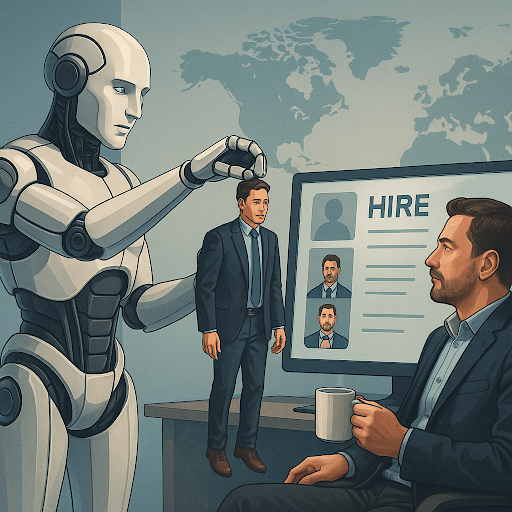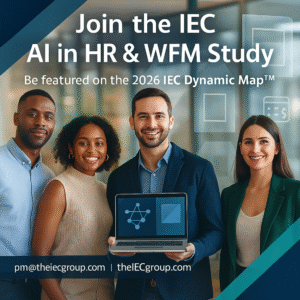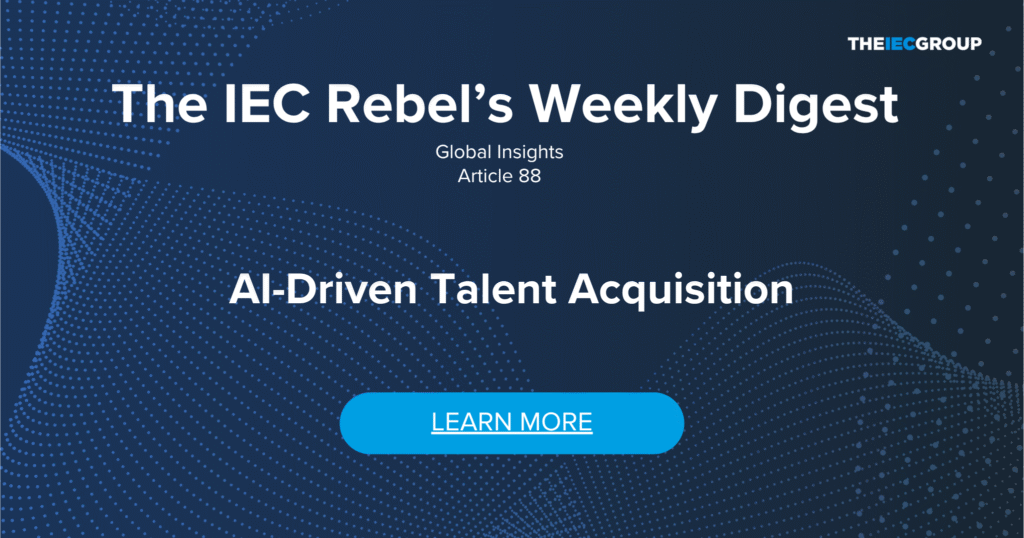AI-Driven Talent Acquisition
Executive Summary
 AI is rapidly transforming talent acquisition—from how we source candidates to how we screen, engage, and measure quality of hire. But let’s be clear: this is not about machines taking over recruiting. It’s about amplifying human intelligence. The future of hiring belongs to organizations that combine AI precision with human empathy, context, and judgment.
AI is rapidly transforming talent acquisition—from how we source candidates to how we screen, engage, and measure quality of hire. But let’s be clear: this is not about machines taking over recruiting. It’s about amplifying human intelligence. The future of hiring belongs to organizations that combine AI precision with human empathy, context, and judgment.
Our latest IEC Rebel’s Digest section on AI-Driven Talent Acquisition dives deep into how leading companies are redesigning their hiring funnels around data, governance, and human-in-the-loop decision-making. We explore the tools, architectures, and measurable outcomes that are redefining speed, fairness, and candidate experience—without losing the personal touch that makes recruitment meaningful.
You’ll find practical playbooks for CHROs, recruiters, and HR tech providers, plus the maturity models and governance standards shaping tomorrow’s AI-enabled HR landscape.
This article is also a preview of one of the three categories of the first global IEC study on “AI in Talent Management and Development”, which will benchmark the world’s most advanced providers.
Vendors and HR leaders alike are invited to participate free of charge and help define what responsible, human-centered AI in HR truly looks like.
Join the study today and be part of shaping the future of intelligent, ethical hiring.
The punchline
The hiring playbook is being rewritten by AI—faster sourcing, sharper matching, richer candidate experience, and materially better quality of hire at a lower cost per hire. But the winners won’t just plug in a chatbot. They’ll redesign the end-to-end funnel around data, models, and governance, then wire AI into worktech, marketing, and finance to make hiring a measurable growth engine.
Why now (and why this time is different)
Past waves (ATS, programmatic ads, chatbots) delivered incremental gains. Foundation models, vector search, and agentic workflows are different because they reason across unstructured inputs at scale—CVs, portfolios, emails, interviews, code repos, and even signals from internal performance systems. That unlocks:
- Precision sourcing from open web + private talent pools
- Contextual matching that understands skills, projects, and adjacent capabilities
- Personalized engagement at candidate-level granularity
- Manager-grade screening via structured, auditable interview agents
- Closed-loop improvement as outcomes feed back into models
The shift is not “AI as a tool,” it’s talent acquisition as a data product.
What “good” looks like (reference blueprint)
Think in three layers:
- Data & Identity Layer
- Unified candidate graph: resumes, assessments, interview notes, CRM activity, referrals, work samples.
- Skills ontology with normalization (ESCO/ONET-aligned plus your custom skills).
- Consent, provenance, and purpose tagging (GDPR-grade; ready for EU AI governance).
- Event stream from ATS/HRIS/LMS to track funnel transitions.
- Model & Reasoning Layer
- Retrieval-augmented generation (RAG) over your private candidate corpus.
- Role ontologies and success profiles based on top-performer signals.
- Agentic workflows for JD creation, sourcing, screening, scheduling, and rejection/offer messaging.
- Bias monitors: demographic parity checks & counterfactual evaluation for model outputs.
- Safety rails: policy prompts + deterministic guard functions for compliance and tone.
- Workflow & Experience Layer
- Recruiter cockpit: pipeline health, ranked slates, “why this candidate,” risk flags.
- Hiring manager app: structured interview kits, instant feedback summarization, decision support.
- Candidate experience: self-serve Q&A, tailored prep, transparent timelines, and status nudges.
- Governance board: audit logs, versioned prompts, model cards, exception approvals.
Core use cases (and what changes in practice)
1) JD + Skills Design: Generate JDs that anchor on outcomes (90-day impact) and measurable skills; auto-map to pay bands and internal career paths. Result: fewer inbound mismatches, better diversity of qualified applicants.
2) Multisource Sourcing: AI agents traverse internal CRM, alumni, silver medalists, and public profiles to build a slate with explanations. Recruiters validate, then launch hyper-personalized outreach at scale.
3) Screening & Shortlisting: Agents evaluate resumes and work samples against structured must-have/nice-to-have skills and adjacent capabilities. Output is a ranked list with evidence and risk notes (e.g., “gap in last project scope; request example”).
4) Interview Intelligence: Interview kits are generated from the JD and success profile; live co-pilot suggests follow-ups and captures structured evidence. Post-call, transcripts are summarized into competency scores with traceable citations.
5) Assessments & Work Samples: Generative tasks aligned to real work (e.g., refactor code, write a brief, reconcile a dataset) with rubrics. AI scores first-pass; humans arbitrate edge cases. Keeps signal, cuts time.
6) Scheduling & Orchestration: Agents coordinate calendars, reschedules, and time zones; they confirm prep materials with candidates and surface interviewer coaching tips. Time-to-schedule becomes near-zero.
7) Offer & Close: AI drafts offers aligned to comp policy, predicts acceptance risk, and suggests negotiation ranges based on internal equity and market bands.
8) Quality of Hire Feedback Loop: Post-hire performance, tenure, and ramp metrics feed models to continuously recalibrate sourcing and screening criteria.
Measurable outcomes you can expect
Ranges below reflect aggregated outcomes we see where orgs do the process redesign, not just tooling:
- Time-to-slate: ↓ 50–80%
- Time-to-hire: ↓ 30–50%
- Cost-per-hire: ↓ 20–40% (media + agency + recruiter hours)
- Qualified pass-through rate (apply→screen): ↑ 2–3×
- Offer acceptance: ↑ 5–10 pts from personalization + speed
- Quality of hire (first-year performance/retention): ↑ 10–20%
Risks & how to de-risk them (pragmatically)
- Bias & fairness: Use paired prompts, red-team tests, and counterfactual CVs; monitor selection parity and explainability dashboards per stage.
- Privacy & IP leakage: Strict RAG with scoped indexes; prevent model training on your data; redact PII before vectorization.
- Hallucination & overreach: Evidence-required outputs; force citation of source chunks; reject answers without traceability.
- Vendor lock-in: Keep your skills ontology + embeddings portable; insist on exportable candidate graphs and prompt libraries.
- Regulatory drift: Treat AI policies like SOX controls—versioned, auditable, with exception management and DPIAs where appropriate.
Build vs. buy (and the hybrid reality)
- Buy if you need speed, standard workflows, and strong compliance posture.
- Build if you have unique datasets (e.g., proprietary portfolios) and engineering depth to encode domain-specific reasoning.
- Hybrid: Buy the orchestration and governance; bring your data and prompts; extend with your own micro-agents for differentiators (e.g., niche role taxonomies).
A maturity model you can actually use
Level 1 – Tools: Point features (AI resume parser, JD generator).
Level 2 – Assisted: Recruiter co-pilot for sourcing/screening, simple automations.
Level 3 – Orchestrated: End-to-end funnel agents with human-in-the-loop; centralized governance and audit.
Level 4 – Predictive: Quality-of-hire feedback loops, talent demand forecasting, budget optimization.
Level 5 – Strategic: Talent supply integrated with workforce planning, L&D, internal mobility; hiring as a leading indicator in the operating plan. Ongoing measurements and improvements.
Most enterprises can move from Level 1→3 in 6–9 months if they standardize data contracts and commit to change management.
Implementation playbook (90/180/365 days)
Day 0–90: Foundation & quick wins
- Stand up a talent data lake: ATS/CRM exports, interview notes, assessments, candidate communications.
- Choose a skills ontology; normalize historical data; tag consent and purpose.
- Pilot three high-leverage roles (e.g., sales AE, backend engineer, FP&A analyst) with JD→sourcing→screening agents.
- Establish AI governance: model cards, prompt repos, DPIA template, fairness KPIs.
Day 90–180: From pilot to platform
- Roll out interview intelligence and assessment agents for your top five job families.
- Integrate comp bands and offer generation with finance guardrails.
- Launch candidate experience bot with evidence-based answers + status nudges.
- Implement observability: funnel analytics, bias dashboards, cost attribution.
Day 180–365: Systematize & scale
- Close the loop with quality-of-hire models and ramp analytics.
- Expand to agencies/RPOs with shared governance.
- Build internal mobility flows: talent marketplace powered by the same skills graph.
- Negotiate data portability and source code escrow terms for long-term resilience.
Data you’ll need (and how clean it must be)
You don’t need perfect data to start. You need consistent data:
- JD library with tagged must-have/nice-to-have skills
- Resume corpus (including silver medalists) + interview notes with outcomes
- Assessment results and post-hire performance snapshots
- Compensation bands, geo pay modifiers, and offer history
- Sourcing channel tags and cost data
Aim for 80% coverage and strong consent/provenance tagging. Iterate.
Change management (make the humans great)
- Recruiters: Train to validate AI-ranked slates, not to “out-rank” them. Shift time from manual screening to candidate coaching and hiring manager enablement.
- Hiring managers: Make them power users of interview kits and decision briefs; shorten feedback cycles to hours, not days.
- Legal/works councils: Co-design the safeguards; publish a plain-language AI FAQ for candidates and employees.
- Candidates: Be transparent—explain how AI is used, where humans decide, and how to request a review.
Procurement questions that separate hype from value
- What’s your data boundary? Do you train your foundation models on our data?
- Can we export embeddings, prompts, and labeled datasets at any time?
- Show bias reports and hallucination rates from production, not demos.
- What’s your RAG architecture? How do you ensure source citation for every decision?
- How do you handle consent, DPIA, data subject requests, and retention?
- What are your unit economics? (Cost per 1,000 profiles screened, per interview summarized, per offer generated.)
- How does your roadmap support internal mobility and L&D integration?
Metrics that matter (tie to business)
- Speed: time-to-slate, time-to-first-interview, time-to-offer
- Quality: first-year retention, ramp time, manager satisfaction
- Efficiency: recruiter hours per hire, cost-per-hire by channel, agency utilization
- Fairness: stage-by-stage parity, adverse impact ratio, explanation coverage
- Experience: candidate NPS/CSAT, drop-off at each stage, ghosting rate
- Strategic: hires vs. plan, productivity impact, vacancy cost avoided
The intersection with Workforce Management (WFM)
Staffing, scheduling, and compliance live downstream of TA. When AI shares a skills graph with WFM, you can:
- Forecast labor demand and pre-build talent slates.
- Route shift preferences and part-time availability into sourcing messages.
- Ensure credential checks (licenses, clearances) are verified at source and synced to scheduling.
- Spin up surge teams for seasonal peaks with pre-qualified pools.
Short, sharp recommendations
For CHROs/TA leaders (next actions)
- Name an AI in TA Owner. One accountable leader across TA, People Analytics, and Legal.
- Start with three roles. Design the end-to-end funnel and ship a live pilot in 90 days.
- Lock your ontology. Choose the skills framework now; don’t let vendors fragment it.
- Measure like FP&A. Instrument unit economics and quality-of-hire; publish a quarterly “Hiring Efficiency Report.”
- Govern visibly. Approve a public AI policy for candidates; instrument fairness dashboards; run quarterly red-teams.
- Own your data. Insist on export rights for embeddings, prompts, and labeled sets.
For Providers (next actions)
- Ship evidence-first UX. Every recommendation needs source citations and “why.”
- Open the edges. Robust APIs, event streams, and portable embeddings; no dark corners.
- Bias toolchain out-of-the-box. Counterfactual testing, parity reports, and mitigations built in.
- Contract for outcomes. Offer time-to-slate and cost-per-hire SLAs; align pricing to value.
- Co-governance. Model cards, prompt versioning, and audit logs accessible to clients by default.
- Integrate WFM. Shared skills graph and credentials sync to scheduling and timekeeping platforms.
Provider landscape (what’s being compared)
In our forthcoming comparative view, we’ll evaluate vendors across:
- Data architecture & portability (RAG design, export rights, consent tooling)
- Matching quality & explainability (evidence trails; model diagnostics; bias reports)
- Agentic orchestration (breadth of automated workflows; human-in-the-loop controls)
- Interview & assessment intelligence (structured kits, scoring validity, anti-cheat)
- Candidate experience (personalization, transparency, multilingual capabilities)
- Integration depth (ATS/CRM/WFM/HRIS; finance & comp systems)
- Security & compliance (PII handling, DPIA support, auditability)
- Economics & outcomes (unit costs, deployment time, ROI evidence)
- Roadmap & ecosystem (internal mobility, L&D, talent marketplace convergence)
Executive one-pager: What to do Monday morning
- Pick your three pilot roles and write success profiles (90-day outcomes + core skills).
- Stand up a RAG sandbox with your historical resumes, interviews, and outcomes.
- Deploy JD and sourcing agents; require evidence citations for every slate.
- Define five funnel KPIs + two fairness KPIs; make them visible in a shared dashboard.
- Publish a candidate AI transparency page and route DSARs to a monitored inbox.
- Negotiate data portability up front with every vendor.
Disclaimer — Don’t Fall for the Hype:
AI won’t magically identify, interview, and hire the perfect candidate while you sip your coffee. Talent acquisition is still—at its core—a people business. AI can amplify human judgment, not replace it. The best results come when smart tech meets smarter humans.
Closing note & invitation
 Provider comparisons—and the identification of the leading AI provider in Talent Acquisition—will be a core part of the first global IEC study on “AI in Talent Management and Development.” Participants are invited to join free of charge.
Provider comparisons—and the identification of the leading AI provider in Talent Acquisition—will be a core part of the first global IEC study on “AI in Talent Management and Development.” Participants are invited to join free of charge.
Participation: pm@theIECgroup.com
Study scope (AI-first lens):
Study #1: AI in Talent Intelligence & Development
- AI-Driven Talent Acquisition
- Performance & Talent Intelligence
- Learning & Development (incl. internal mobility/marketplaces)
Study #2: AI in Workforce Operations & Pay
- AI in Scheduling & Time Management
- AI for Payroll & Compliance
- Total Workforce Orchestration (VMS/FMS, contractors, EOR)
Study #3: Employee Experience & People Insights
- Employee Experience & Virtual Assistants
- Workforce Analytics & Planning
Over the next few weeks, we’ll zoom into each of the eight categories in IEC Rebel’s Digest—one deep dive at a time, with practical use cases, KPIs, and the vendor patterns to watch.
IEC Rebel’s Digest— The IEC Group can help you audit your global employment setup by identifying labor leasing risks, verifying licensing requirements, and ensuring your EOR partners meet every compliance standard—before regulators come knocking.
Last but not Least: If you’re facing challenges and wondering how others are managing similar issues, why not join The Leadership Collective Community? It’s a peer group and webcast platform designed for leaders to exchange insights and experiences.
Introducing the IEC Knowledge Network Free Membership – Your Gateway to Seamless Access!
We are thrilled to present a new service that goes beyond the ordinary download experience. In addition to offering you the ability to download the things you love, we are delighted to introduce the IEC Knowledge Network Free Membership.
The Free Membership option grants you access to our library of articles and videos, without the need for tedious registrations for each piece of content.
The publication serves as a trusted resource to support executives in their pursuit of sustainable and successful global expansion. In addition the IEC Practitioners are available to discuss your specific challenge in more detail and to give you clear advise..
Take advantage of this valuable resource to accelerate your global expansion journey


